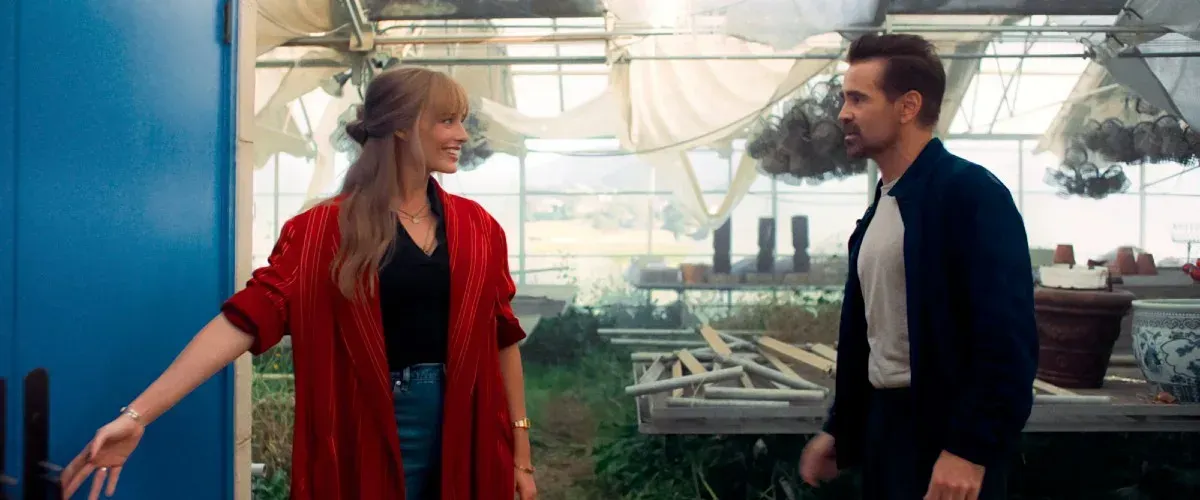Jonah Naplan September 22, 2025
“A Big Bold Beautiful Journey” probably wouldn’t work at all if it had two inferior actors playing the leads. Luckily, it’s got Colin Farrell and Margot Robbie, some of the most attractive and charismatic talents working today, and the movie dotes on them in the hopes that we will, too. Farrell is David, a jaded loner who finds it difficult admitting to himself that he yearns for a greater purpose. Robbie is Sarah, a tricky sort of gal who can never be entirely content with herself and her relationships because she’s so romantically unfaithful. A series of whimsical events tries to get these two characters together by sending them on, well, look at the title.
Director Kogonada has worked in this kind of deeply reflective territory before. His last movie “After Yang,” also starring Farrell, was a masterclass in tone management and was already ahead of its time by telling the story of a family’s experience living with an android. There’s no physical robots in “Journey,” but the mysterious force guiding the characters feels like a mechanical entity, manifesting itself via GPS and making commands in a voice that sounds like Siri or ChatGPT. After meeting and briefly flirting at the wedding of a mutual friend, David and Sarah go their separate ways. They run into each other again at a Burger King on the road. Then Sarah’s car won’t start. By that point, they just accept that fate won’t let them remain separate.
Their journey is punctuated by doors of all varieties. Each one launches the two of them back to the past, as they engage with the uncertainties of such embarrassing and/or personally afflicting time periods. Now, admittedly, the biggest problem with the screenplay by Seth Reiss (“The Menu”) is that it never can decide what these sequences are leading up to nor does it justify how a specific event affected a character and shaped who they are now. Kogonada’s use of visual and emotional storytelling that guided “After Yang” feels somewhat jumbled here, unable to stick to a lane. That to say, they’re still often marvelously entertaining setpieces that are joys to watch even if they never exactly connect beyond the surface level.
Perhaps the film’s stand-out scene is a flashback to David’s freshman year of high school when he starred in his drama club’s production of “How to Succeed in Business Without Really Trying” as J. Pierrepont Finch (it’s a major role—both Daniel Radcliffe and Nick Jonas played him on Broadway). Farrell’s voice is really something special and so is Robbie’s; after the performance, they lead the audience in a sing-a-long that may as well turn this movie into something of a musical, itself. Other thematic highlights include a somber moment at a cafe where both David and Sarah end things with their most recent romantic partners in a four-way dialogue. Anytime they step into the past, they’re “technically” representing their younger selves to the other people in the scene, even if we continue to see them as adults.
Of course, there’s been movies before about despairing adults reliving key events from their past as they reflect on the present (in a sense, this film feels like a spiritual cousin to “The Life of Chuck” from earlier this year in that they both explore similar ideas of existentialism with endless charm), but “Journey” is still a thing all of its own. The quiet, thoughtful nature of Kogonada’s direction got to me by the end, even if his intention isn’t entirely clear. There’s moments in the movie where David and Sarah are dressed in all black and appear to be in some sort of performance studio, intimating that these characters are simply actors performing their lives for each other. It’s an interesting idea, but Kogonada never fully commits to it, and the film’s wonderful connections to theater are lost by the third act. Each of the different storytelling modes that “Journey” explores might have been interesting if they’d been individually allowed to develop over the course of a full movie, but their sporadic, clunky nature blocks such intrigue.
The performances are the best part. As David and Sarah travel further down this road trip into the past, the two of them fall in love despite the realization that such an act might hurt them in the long run. Both actors have the opportunity to display depth, even while knowing that their characters’ problems don’t matter much anyway because this isn’t the kind of movie that will have an unhappy ending. Farrell is great at playing the cool but slightly awkward everyman who you admire but can also feel bad for when the story requires it. Robbie plays a woman with a charming edge not unlike the characters she’s played in other movies, and she knows how to excel in the part. There’s almost nobody else in the movie but Farrell and Robbie, and certainly no other major characters. If slightly tweaked, “Journey” could easily be an effective two-person stage play, but hopefully one that improves the metaphors and figurative devices the film wants us to resonate with.
Mainstream movies used to build themselves around the principle that a couple of strong leads, instead of a big-name IP, could attract people to the theater. “A Big Bold Beautiful Journey” may find some success in this lane, but those who see it might leave feeling as though the destination was cumbersome even if the journey was charming.
Now playing in theaters.

